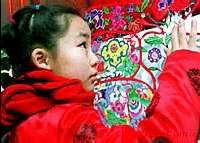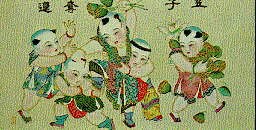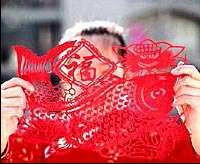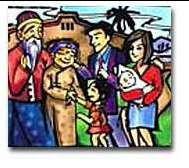Origins and Customs of the Chinese New Year
A Talk by Yanyi Blake |
Chinese New Year
Chinese New Year, also known as the Spring Festival, starts at the beginning of spring. Chinese New Year is China's biggest holiday.The spring festival is the oldest and most important festival in China. The spring festival celebrates the earth coming back to life, and the start of ploughing and sowing. It occurs somewhere between January 30 and February 20. Each Chinese year is represented by a repeated cycle of 12 animals: rat, ox, tiger, rabbit, dragon, snake, horse, sheep, monkey, rooster, dog and pig.
The Chinese calendar
The origin of the Chinese calendar is traced back to Shang Dynasty. Evidence from the Shang oracle bone inscriptions shows that by the 14th century BC the Shang Chinese had established the solar year at 3651/4 days and lunar month at 29½ days. Chinese calendar is a lunisolar calendar. It harmonizes both the lunar cycle and the solar year. The phases of the moon regulate the length of the month and the apparent paths of the sun determine the beginning and the length of he year. New Year's Day is celebrated on the second new moon after the Winter Solstice.
The Chinese calendar normally has 12 moons (months) in a year. Since the phase changes of the moon have a 29½ day cycle, each month is rounded off to either 29 or 30 days. In order to synchronize the lunar cycle of 354 days in 12 months, a leap month is added every 2.7 to 3 years.
New Year preparations
As part of the New Year celebration, people buy presents, decorations, special foods and new clothing. Railroad stations throughout China are filled with travellers who take their vacation days around New Year to return home for a family reunion. Chinese families are busy giving their home a thorough cleaning. It is believed the cleaning sweeps away bad luck and makes the house ready for good luck to enter. In many homes, doors and windowpanes get a new coat of red paint. The home is decorated with paper-cuts and poems called couplets of "happiness", "wealth", "longevity" and "satisfactory marriage with children". Other traditional decorations include window decorations of paper-cut designs.
The Kitchen god was regarded as the guardian of the family hearth. He was the inventor of fire and most important was the censor of the household morals. By tradition, on 23rd of the last month the Kitchen god left the house to report to the heaven on the behaviours of the family. The family gives a ritualistic dinner. In many homes incense was burned, and also in the temples as a mark of respect to ancestors. Accumulated debts should be settled before the last day of the old year.
New Year's Eve
On New Year's Eve, all the members of families come together to feast. It is the time for family reunion and the one who couldn't make it a empty seat would be placed to represent the loved one. Jiaozi, a steamed or boiled dumpling, is popular in the north, while southerners favour a sticky sweet glutinous rice pudding called Nian gao.
After dinner, the whole family stays up all night playing cards, board games or watching TV programs dedicated to the New Year's celebration. Watching The Chinese Central Television's five-hour non-stop New Year Eve's Special has been a modern tradition for the past twenty years. It is a montage of Chinese folk songs and dances, opera pieces, cross talks, acrobatics and comedy skits. The cast are the best-known performers in the country.
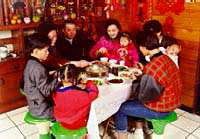
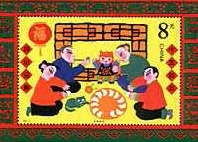
Every host and performing artist across China feels proud to qualify to attend the show and it is best chance to be known by hundreds of millions of viewers. It is also a rare opportunity for Chinese all over the world to gather together through the screen. At midnight, the sky is lit up by fireworks, which symbolize the sending out of the old year and the welcoming in of the New Year. People open all the windows and doors in the house in order to let the old year go out.
New Year's Day
Very early the next morning, children greet their parents and receive their New Year present: Money wrapped in red envelopes. The rest of the first day of the New Year is spent visiting relatives, friends and neighbours to express their New Year greetings.
There are many ancient superstitions still practiced on New Year's Day in China. Many people do not eat meat on this day because they believe it will give them happy lives for the rest of the year. It is believed that if you cry on New Year's day, you will cry all through the year. Therefore children are indulged by their parents, even though they might be naughty they are not punished on New Year's Day!
Chinese New Year is a time for reconciliation. Old grudges are forgiven. People are warm and friendly to each other. Sometimes people exchange gifts. An important part of the New Year celebration is to honour and respect relatives and ancestors. New Year's Eve and New Year's Day are celebrated as a family affair, a time of reunion and thanksgiving. The thanksgiving celebration is highlighted with a ceremony given in honour of Heaven and Earth, the gods of the household and the family ancestors.
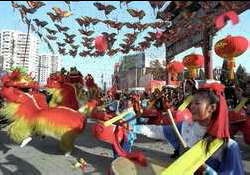
The ancient custom of holding Temple Fairs to offer sacrifices at New Year has developed into a modern seven-day festival, with fun-filled hours of food, dance performances, games and souvenir stalls.
In recent years farmers bring more and more folk performances and game tricks to entice the passers-by. There are Peking operas, comic dialogs, acrobatics, mini-carvings, mask drawings, clay figurines and magic shows.
The second day of the new year
The second day of the new year is a day the gods return to the living world. It is also a day for married women return to their native home to visit family and relatives.
The Seventh day of the New Year
This day is everybody's birthday. The individual's birthday is not as important as the New Year's celebration so that people celebrate birthday together on this day. This is also the time for farmers to show off their produce. People continue socializing and enjoy all kinds of entertainments.
The Lantern Festival
The lantern festival has been part of Chinese New Year celebrations since the Han Dynasty (206 BC- 221 AD). It is usually held on the 15th day of the first month of the lunar calendar and marks the end of New Year festivities.
It is said that the holiday evolved from ancient Chinese belief that celestial spirits could be seen flying about in the light of the first full moon of the lunar calendar. To aid them in their search for the spirits they used torches. These torches gave way to lanterns of every shape, size and colour. Today lantern festivals are held each year in China, Hong Kong, Singapore and Taiwan to mark the end of Chinese New Year celebrations. Competitions are held to select the best lanterns.
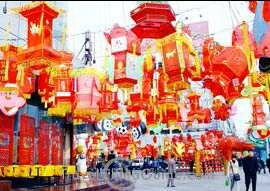
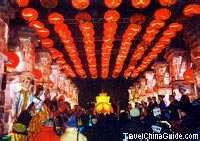
The lanterns come in all shapes and sizes. Some are created in the form of animals, insects, flowers, people or even machines or buildings. Others depict scenes from popular stories teaching filial piety and traditional values. A favourite subject is the zodiac animal of the year - which in 2006 is the dog. Part of the lantern festival tradition involves a game to guess riddles attached to the lanterns. In the old days the riddles were obscure literary allusions to the Chinese classics and so were mainly the preserve of the educated classes. Like most Chinese festivals, the Lantern Festival has its own special food called "Tang Yuan" - round glutinous rice dumplings with sweet or spicy fillings. The dumplings are said to symbolise both the first full moon and family unity and completeness.
Stilt walking, drumming and dragon and lion dancing are all traditional forms of festival entertainment. In Asia, it is not uncommon to see processions of hundred-foot long dragons, lit with flashing eyes and luminous bodies, accompanied by pounding drums, cymbals and brass instruments.
Chinese New Year customs vary from place to place in China because China is a big country geographically, demographically and ethnically. But the spirit underlying the diverse celebrations of the New Year is the same, a sincere wish of peace and happiness for family members and friends.



